Here, we provide some additional materials related to the ideas discussed in Connected, with an emphasis on audiovisual materials and graphics we could not include in the book. We also include elaboration of some of the ideas, as well as some new topics not included in the book.
CHAPTER 1
THE HUMAN WAVE, or LA OLA
Social networks can have properties and functions that are neither controlled nor even perceived by the people within them. These properties can sometimes only be understood by studying the whole group and its structure, not by studying isolated individuals. Simple examples include traffic jams and stampedes. You cannot understand a traffic jam by just interrogating one fuming person at the wheel of his car, even though his immobile automobile contributes to the problem. Complex examples include the notion of human culture itself, or, as we describe in Connected, the fact that groups of interconnected people can exhibit complicated, shared behaviors without explicit coordination by a leader.
Many simple examples of this can be understood best if we completely ignore the will and cognition of the individuals involved and treat people as if they were "zero intelligence agents." Consider the human waves at sporting events that first occurred during the 1986 World Cup in Mexico. In this phenomenon, originally called La Ola ("the wave" in Spanish), sequential groups of spectators leap to their feet and raise their hands, and then quickly drop down again. The effect is quite dramatic. A group of physicists who usually study waves on the surface of liquids were sufficiently intrigued that they studied a collection of filmed examples of La Ola in enormous soccer stadiums, and they noticed that these waves usually rolled in a clockwise direction and consistently moved at a speed of 20 "seats per second." [I. Farkas and others, "Mexican Waves in an Excitable Medium," Nature 419 (2002): 131-132.]
THE CHILDREN'S GAME OF TELEPHONE
The children's game of telephone, also known as a "whisper chain," is an example of a simple, organized network, similar to a bucket brigade. Usually, the game is amusing since the message gets degraded and transformed as it passes for person to person. What may be the longest chain where the message did not degrade was 59 people long, and it was arranged on July 14, 2009.
"Jake Bronstein began a whisper chain that successfully passed through 59 people, a new world record. With his girlfriend Kristina Hoge completely unaware of the plan, Bronstein sent the message ‘Kristina, will you marry me?' around a roomful of strangers. After the proposal passed through 59 people, a random stranger whispered the message in the ear of a completely shocked Hoge. She accepted onstage in front of a jubilant, tearful crowd."
PURPOSEFUL VERSUS NATURAL NETWORKS
One of the most basic observations about networks is that diverse phenomena – whether information, emotions, germs, or money – diffuse through them. And each person influences others (and is influenced by others) up to three degrees of separation (i.e., up to their friends' friends' friends). Whether you gain or lose weight, start or stop smoking, become happy or sad, go to the polls or abstain: all these activities depend, in part, on the similar behaviors of your friends, your friends' friends, and even your friends' friends' friends. But generally not further. We call this the "Three Degrees of Influence Rule," and it has its origin in a number of fundamental social and biological properties of social networks.
One explanation for this rule is that information generally becomes less precise as it is transmitted, feelings become less intense, and motivations become less strong. One study of people looking for a piano teacher, for example, shows that piano teachers get the majority of their clients from other clients who are within three degrees of separation from them. And our own work indicates that your weight, smoking behavior, and happiness are influenced by your friends, your friends' friends, and your friends' friends' friends. But beyond that point, the influence becomes negligible.
Yet, this fundamental observation about human social networks pertains only to natural social networks. In their ingenuity, humans have invented ways to circumvent Nature by creating artificial or purposeful networks. These networks differ from natural networks in three ways: (1) they have a totally different structure, (2) they tend to be organized for a specific purpose that everyone within them is aware of, and (3) they often have mechanisms to foster or preserve communication between connected people. The contrast between the two types of networks can be appreciated by comparing the structure of the two networks below. One is a natural network of 105 college students, and the other is an artificial network of 100 people organized into a telephone tree of the kind used in every town in America to disseminate news about school closings. Each circle is a person, and each line connecting them is a tie between two people. In the case of the telephone tree, the lines are arrows, indicating the "direction" of the relationship and the flow of information, whereas in the natural social network shown, the relationships are two-way.
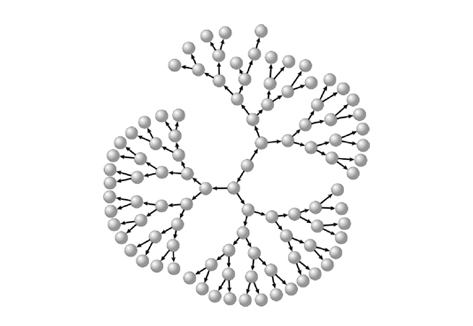
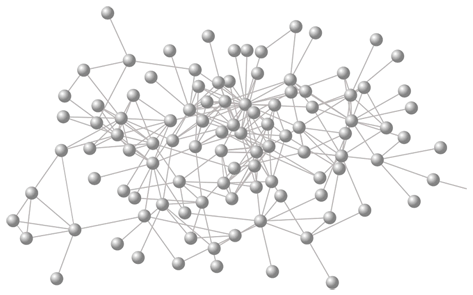
For a short essay we have written on the difference between artificial and natural social networks, and how artificial networks often successfully transcend the "Three Degrees of Influence Rule" discussed in Connected click here.
CHAPTER 2
THE IMITATION OF SPEECH AND BODY LANGUAGE
People who like each other imitate each others' body postures during their conversations. Here's a description of this phenomenon from a 2008 article by Richardson and colleagues, "Synchrony and Swing in Conversation: Coordination, Temporal Dynamics and Communication," in Embodied Communication, Wachsmuth, I, Lenzen, M. & Knoblich, G. (Eds.) Oxford University Press.
"When two people exchange words, they share a great many things besides. For example, [people] will spontaneously converge upon dialect, speaking rate, vocal intensity, and pausing frequency. Even without interacting with them, people will spontaneously imitate the speech patterns of others. But conversational partners do not limit their behavioral coordination to speech. They spontaneously move in synchrony with each other's speech rhythms and match one another's postures. LaFrance, for example, demonstrated that listeners tend to mirror a speaker's posture whom they find engaging. Imitation can be found throughout human interaction: neonates imitate facial gestures, infants imitate vocalic sounds, and adults spontaneously imitate facial expressions."
Psychologists who study perception in the laboratory have done many creative experiments to understand the biology and psychology of coordinated thoughts and actions. For example, psychologist Daniel Richardson, at University College London has looked at how people instinctively coordinate their gaze, and how this affects their ability to comprehend each other better. In one experiment, a speaker discusses and episode of the sitcom Friends, and two others listen to what she is saying. As she is talking, her eyes flicker around the images of the six protagonists of the show, and the listener who follows her gaze is better able to recall what she said.
Below is Dr. Richardson's description:
"The speaker's gaze is a cross hair [indicating where she is looking as she talks about her favorite episode of Friends] and the dots are two different people listening. You can see that the lighter dot appears to have a tighter coordination with the crosshair compared to the darker dot. That listener with the lighter dot later recalled what the speaker had said with much higher accuracy. This link between gaze coordination and speech comprehension appears to be causal, as Richardson and his colleagues have shown in later experiments where flashes on the screen cause a listener's gaze to follow a speaker's more closely, and consequently improve comprehension by the listener [that is, when the listener's gaze is ‘forced' to follow the speaker]."
As we discuss in Connected, there are many mechanisms – social, biological, psychological, and otherwise – by which phenomena (such as accurate knowledge about a TV show) might spread from person to person, and some of them seem to be very hardwired. People are innately inclined to synchronize and copy many aspects of behavior they observe in others.
CHAPTER 3
THE ROLE OF DANCING IN THE MEETING AND EVALUATION OF STRANGERS
In Connected, we discuss how people meet their partners as well as the role of chance events and of introductions. A key problem in meeting total strangers, or even getting to know people to whom you have been introduced, is breaking the ice. In this regard, it is noteworthy how salient dancing is in such events. Dancing provides a way to assess the appearance, movement, and style of a potential partner, and it can be assessed from a distance without any awkward conversation or direct interaction. Dancing provides a common language, and a solution to the problem of interacting with a stranger, since it follows set rules. Moreover, dancing functions as a means to synchronize the behavior - and the emotions - of the two parties. It's a kind of ritualized social contagion devoted to sex.
And, in fact, dancing turns out to be very important for creating social ties. For example, one study found that one in four people met their spouse while at an event involving dancing. [M. Bozon and F. Heran, "Finding a Spouse: A Survey of how French Couples Meet," Population: An English Selection, Vol. 44, No. 1 (Sep., 1989), pp. 91-121]
Evolutionary biologists attribute the importance of dancing to its ability to showcase a person's fitness and suitability as a reproductive partner. Charles Darwin suggested as early as 1871 that dance is a sexually selected courtship signal that may reveal information about the genes of the dancer. In this way, humans may be no different from birds displaying bright plumage to potential mates to show off their reproductive fitness. In fact, our dancing is almost as stylized as that of other species. For many decades in the US and Europe, traditional dancing interactions have involved a sequence of dances that most people recognize, from initial "fast" dances to loud music that involve no contact and no real chance for conversation, to subsequent "slow" dances that allow for further interaction, including physical contact and conversation, if both parties want.
A 2007 article in the scientific journal Nature sought to uncover the biological basis of human dancing by studying a sample of 40 people in a society (Jamaica) in which dancing is important to the social lives and courtship of both sexes. [W.M. Brown, et al, "Dance Reveals Symmetry Especially in Young Men," Nature 2005; 438: 1148-1150]. The researchers used motion capture video to develop animations of people dancing but these animations had no indications of the people's appearance (indeed, even the sex of the dancers became largely undetectable). These videos were then shown to 155 men and woman to rate the quality of the dance; these evaluators could not know anything about the appearance of the dancers, just the nature of their dancing. The investigators also measured the degree of bodily symmetry of the dancers, which was not visible in the animations. They found that there was a strong correlation between body symmetry and the dancing ability as assessed by the evaluators. And previous research had shown that people whose faces and bodies are more symmetrical are regarded as more attractive and that such people have other fitness advantages in terms of survival and reproduction. In other words, good dancers are typically more attractive and more fit, even when they are not dancing.
Click here for the investigators' descriptions of their process and for more video of computer animations of good and bad Jamaican dance.
CHAPTER 4
MAKING MOVIES OF SOCIAL NETWORKS
In Connected, we review some of our work, which we started in 2002 with support from the National Institute on Aging, on the spread of health phenomena in social networks. We began with a study of obesity (which we published in 2007), but then we went on to study smoking, drinking, depression, happiness, loneliness, and many other health-related phenomena. These projects involved various datasets, including most especially the Framingham Heart Study Social Network dataset that we assembled and are continuing to assemble and analyze.
When we first began this work, we had an image in our minds that the spread of phenomena in networks might be visualized the same way one might see a wave spreading out from a pebble dropped in a pond. But the situation proved much more complicated than that, as we describe in Connected.
Below is the first video we made, showing the spread of obesity, with a narration describing what is happening:
This video is a dynamic graphic representation showing a portion of the Framingham Heart Survey social network involving 2,200 people depicting (1) the spread of obesity in the network, (2) ties within the network, and (3) the change in those ties over 32 years. Since obesity is a multi-centric epidemic, there are many foci with many people influencing each other and forming ties in complex ways.
Each circle or "node" represents one person in the data set. Nodes with red borders are women, and nodes with blue borders are men. The size of each node is proportional to the subject's BMI. In addition, the interior color indicates the obesity status of the individual subject. Yellow nodes represent obese persons with a BMI greater than 30 kg/m2, and green nodes represent non-obese subjects. Each line between two nodes represents a social connection between two people. Purple lines denote close genetic ties such as parents, children, and siblings. Gray lines denote non-genetic relations such as friends and spouses.
Below is a video of one of us talking about how seeing this video was both the most exciting and the most depressing moment of our scientific career: (Note: this video presentation is an hour long, and the description of the obesity video comes in at about ten minutes.):
Below is a narrated animation of the spread of smoking behavior in social networks, analogous to the spread of obesity:
Original versions of these videos are available for download at the authors' websites, christakis.med.harvard.edu and jhfowler.ucsd.edu.
The reasons these videos are scientifically valuable, and the reason that the underlying data that was used to generate them is informative, is that they are longitudinal. In most prior work examining social networks, researchers only had access to static data about the structure of the network and about the attributes of the individuals in it. But, as desribed in Connected, we were able to assemble data that changed across time, and this allowed us to make progress in understanding how networks function. It is as if you were trying to understand the rules of a foreign game (cricket? baseball?) but had only a snapshot to rely on. How much better would it be to have a movie of the game. We made movies of social networks.
CHAPTER 5
SHOW ME THE MONEY
Here's the link to Where's George, the website that Dirk Brockmann and his colleagues used to get data about the flow of paper money in our society. The money is tracked by people who voluntarily log on to a website to key in the serial numbers of bills that pass through their hands. Data from this website was unexpectedly valuable despite its origins as a hobby: it allowed Brockmann and his colleagues to model how a deadly pathogen might spread from person-to-person, as described in Connected: www.wheresgeorge.com
CHAPTER 6
THE SHAMPOO COMMERCIAL
Below is the shampoo commercial from the 1970s that shows the exponential power of social networks. This is the commercial that motivated James to study the effect of social networks on voting.
THE IRANIAN BLOGOSPHERE
Researchers at the Berkman Center for Internet and Society at Harvard Law School examined the network structure of the political blogosphere. The first country they studied was Iran, and they collected daily information for seven months from almost 100,000 Persian language blogs. Investigators John Kelly and Bruce Etling were very interested in whether or not the blogosphere had a personal impact on freedom of speech or a more global impact on Iran's prospects for liberalizing their form of government. Given Iran's reputation for political repression, they expected to find a tightly controlled and repressive political discourse. But, as we describe in Connected, what they found instead was a network of blogs that was not that different from those found in the free world.

Color plate 7 (above) in Connected shows a map of the Iranian blogosphere, taken from their work. Distinct colors indicate "communities" of blogs that link much more to one another than to the rest of the blogosphere (labels indicate the name researchers gave each community). The two circled nodes are blogs written by two important political leaders, former President Mohammad Khatami and President Mahmoud Ahmadinejad. As Kelly and Etling note: "Iranian bloggers include members of Hezbollah, teenagers in Tehran, retirees in Los Angeles, religious students in Qom, dissident journalists who left Iran a few years ago, exiles who left thirty years ago, current members of the Majlis (parliament), reformist politicians, a multitude of poets, and quite famously the President of Iran, among many others." Here is the link to their original paper.
CHAPTER 7
DOUBLE TAKE PARADE
There is a sleepy town called Twinsburg in rural Ohio that attracts the attention of scientists from around the world every year. An annual Twins Days festival is held in Twinsburg, complete with carnival games, hay rides, and funnel cake, and over 1,000 pairs of twins visit show up – making it the largest annual gathering of twins in the world. Each year, things start off with a wiener roast for the twins and their families, followed by events open to the public like the "Double Take Parade" where the twins march by twos from the center of town to the fairgrounds, and a series of twin contests, including several "most alike" and "least alike" competitions.
And tucked away to one side is another spectacle, albeit more subdued. Dozens of researchers travel to the festival to study the health and behavior of twins. In the research tents, twins participate in studies that ask them questions about their childhood, take saliva and blood samples, administer vision and hearing tests, and even do dental exams. One year, we too went there to collect some data, as we discuss in Connected, because twins provide a kind of "natural experiment" that can allow scientists to disentangle the role of genes and the environment in human behavior.
Here is a link to the Twins Day's Festival in Twinsburg: http://www.twinsdays.org/
CHAPTER 8
THE CORRUPTED BLOOD EPIDEMIC
Chapter 8 in Connected opens with a description of an unusual case of a virtual world epidemic that provided scientists with an opportunity to study real-world behaviors. Known as "corrupted blood," this epidemic took place in the massively multiplayer game of World of Warcraft.
For an image of a victim affected by corrupted blood, taken from the original paper [E. T. Lofgren and N. H. Fefferman, "The Untapped Potential of Virtual Game Worlds to Shed Light on Real World Epidemics," The Lancet Infectious Diseases 7 (2007): 625–629], click here.
For more regarding this episode, click here.
For an NPR interview with one of the authors of a scientific paper about this episode, Dr. Nina Fefferman, click here:
'Virtual' Virus Sheds Light on Real-World Behavior, by Laura Sydell, October 5, 2005.
Below is a narrated video introduction to World of Warcraft by Ta-Nehisi Coates:
VIRTUALITY IN ONLINE INTERACTIONS
As we discuss in Chapter 8, one of the distinctive features of online interactions is 'virtuality,' or the ability of people to assume identities that are quite distinct from their real-life ones. For instance, as shown in the photo below, disabled people can have able-bodied avatars. It is not hard to imagine why this boy would choose this steel-encased, invulnerable avatar. Or men might have female avatars, and vice versa.
Photojournalist Robbie Cooper spent three years, travelling to places like Korea, China, France, and Germany to photograph people who created particular avatars, and he paired photos of the people with their avatars in a remarkable series.
![]()
A VIRTUAL REPRISE OF THE MILGRAM
OBEDIENCE EXPERIMENTS
Experiments such as the famous Milgram obedience experiment would not be allowed under current ethical norms. But they might, in fact, be replicable in the virtual world, as shown by computer scientist Mel Slater and colleagues [in M. Slater and others, "A Virtual Reprise of the Stanley Milgram Obedience Experiments," PLoSONE 2006; 1(1): e39. doi:10.1371/journal.pone.0000039]. Click here for the original paper and its very informative supplement.
Below is a picture of the experimental set-up:
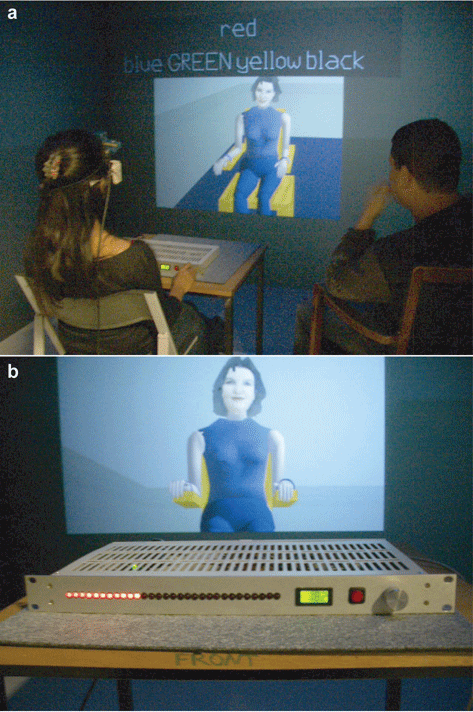
CHANGES IN HUMAN MOBILITY IN ONE FAMILY OVER 100 YEARS
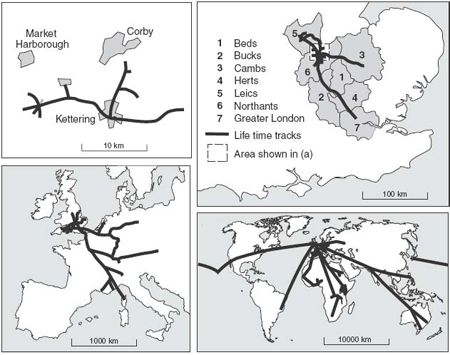
Changes in human mobility over the centuries, as discussed in Connected, have had implications for the kinds of social connections people can, and do, form. These changes in mobility are very nicely illustrated by some work that epidemiologist David Bradley did over the course of investigating his own genealogy [D. J. Bradley, "The Scope of Travel Medicine" in Travel Medicine: Proceedings of the First Conference on International Travel Medicine, edited by R. Steffen (Berlin: Springer-Verlag, 1989): 1–9.]. Bradley documented the travel patterns of his great-grandfather, grandfather, father, and himself, during the century leading up to the 1990s, as shown in the figure.
Bradley's great-grandfather led a very circumscribed life around a village in Northamptonshire in the British Midlands, never leaving a square patch on the surface of our planet with 40 km sides. His grandfather moved about a bit more, including traveling to London, but was still limited to a square in southern England with 400 km sides. Bradley's father traveled all over Europe, covering parts of a square with 4,000 km sides, and Bradley himself became a globetrotter, covering the whole planet, with a 40,000 km circumference. Roughly speaking, with each generation, the range of travel increased tenfold. To keep this up, Bradley's son would have to be an astronaut.
Macro-social changes like this – of rising population, rising population density, and increased mobility – affect myriad aspects of our social experience and our social networks, even if we are just minding our own business and not moving about at all, since they put us into greater contact not just with new sorts of people, but with new sorts of things ranging from germs to ideas.
THE HISTORY OF ONLINE SOCIAL NETWORK SITES
While humans have always been embedded in social networks, it has only been since the late 1990's that these networks have had a visible, virtual existence. The figure below summarizes the timeline of the introduction of online social network sites, from 1997 to 2006. A longer description of the history of social network sites, by Danah Boyd and Nicole Ellison, is available here.
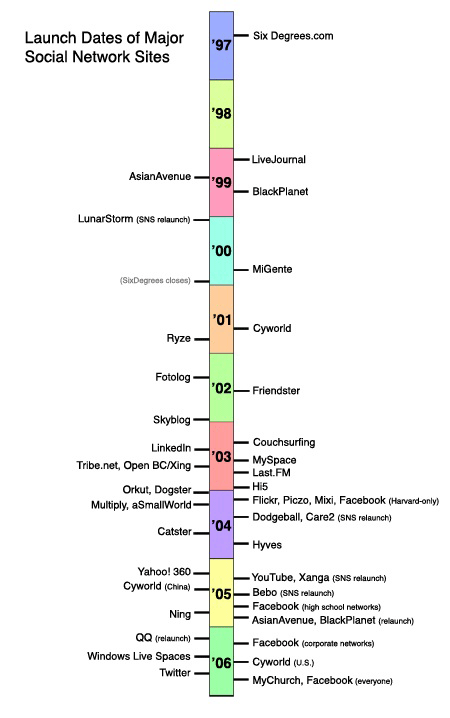
THE CLUSTERING OF TASTES IN MOVIES, BOOKS, AND MUSIC IN FACEBOOK NETWORKS
The Beatles, Coldplay, Dave Matthews Band, Green Day, Jack Johnson, Red Hot Chili Peppers, U2, Led Zeppelin, the Killers, and Simon and Garfunkel were the ten most frequently listed groups on the Facebook profiles of 1,700 college students we studied over the course of four years. Of these, only two showed significant signs of contagion. If a friend liked The Beatles, it doubled the likelihood that a person liked them the following year. Meanwhile, if a friend liked the Killers, it increased the likelihood by a whopping 11-fold!
The network picture below shows the result of these two different intensities of contagion:

Much like the real-world obesity epidemic that we have studied, a contagious appreciation of the Beatles appears to be multi-centric, originating in lots of different corners of the network at the same time. In contrast, fans of the Killers were grouped into tight clusters – like the groups of smokers we previously found in our study of the spread of smoking cessation.
For a longer essay about our work looking at tastes as expressed by students in their facebook profiles, including the role of social influence in movies and books, click here.
TWITTER MAY SPREAD INFORMATION, BUT NOT CHANGE BEHAVIOR
When it comes to online interactions, twitter may be good for spreading information, but not for actually changing behavior. The reason is partly that it is not just the number of ties that matters online, it is also the nature and quality of these ties. Connections between people online are usually weak ties, not strong ties such as those to our family, next-door neighbors and real friends. As it turns out, a serendipitous series of tweets about our book, Connected, by actress Alyssa Milano, media mogul Tim O'Reilly, and internet expert Susannah Fox help make this point, as we discuss here.
SUGGEST A LINK
Click here to suggest a link to Nicholas Christakis and James Fowler that might be added to this page.


